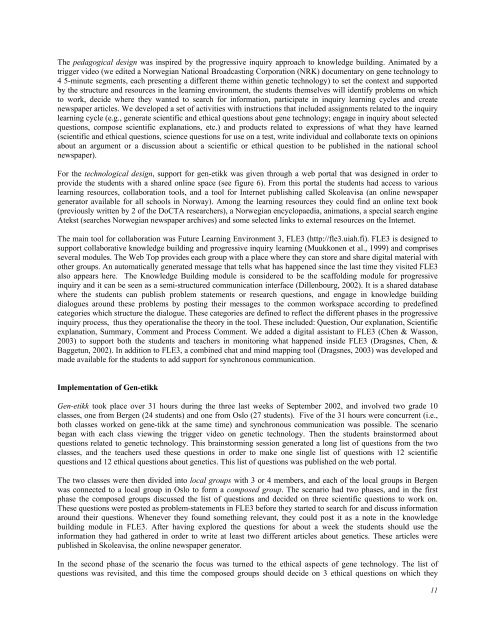October 2007 Volume 10 Number 4 - Educational Technology ...
October 2007 Volume 10 Number 4 - Educational Technology ...
October 2007 Volume 10 Number 4 - Educational Technology ...
Create successful ePaper yourself
Turn your PDF publications into a flip-book with our unique Google optimized e-Paper software.
The pedagogical design was inspired by the progressive inquiry approach to knowledge building. Animated by a<br />
trigger video (we edited a Norwegian National Broadcasting Corporation (NRK) documentary on gene technology to<br />
4 5-minute segments, each presenting a different theme within genetic technology) to set the context and supported<br />
by the structure and resources in the learning environment, the students themselves will identify problems on which<br />
to work, decide where they wanted to search for information, participate in inquiry learning cycles and create<br />
newspaper articles. We developed a set of activities with instructions that included assignments related to the inquiry<br />
learning cycle (e.g., generate scientific and ethical questions about gene technology; engage in inquiry about selected<br />
questions, compose scientific explanations, etc.) and products related to expressions of what they have learned<br />
(scientific and ethical questions, science questions for use on a test, write individual and collaborate texts on opinions<br />
about an argument or a discussion about a scientific or ethical question to be published in the national school<br />
newspaper).<br />
For the technological design, support for gen-etikk was given through a web portal that was designed in order to<br />
provide the students with a shared online space (see figure 6). From this portal the students had access to various<br />
learning resources, collaboration tools, and a tool for Internet publishing called Skoleavisa (an online newspaper<br />
generator available for all schools in Norway). Among the learning resources they could find an online text book<br />
(previously written by 2 of the DoCTA researchers), a Norwegian encyclopaedia, animations, a special search engine<br />
Atekst (searches Norwegian newspaper archives) and some selected links to external resources on the Internet.<br />
The main tool for collaboration was Future Learning Environment 3, FLE3 (http://fle3.uiah.fi). FLE3 is designed to<br />
support collaborative knowledge building and progressive inquiry learning (Muukkonen et al., 1999) and comprises<br />
several modules. The Web Top provides each group with a place where they can store and share digital material with<br />
other groups. An automatically generated message that tells what has happened since the last time they visited FLE3<br />
also appears here. The Knowledge Building module is considered to be the scaffolding module for progressive<br />
inquiry and it can be seen as a semi-structured communication interface (Dillenbourg, 2002). It is a shared database<br />
where the students can publish problem statements or research questions, and engage in knowledge building<br />
dialogues around these problems by posting their messages to the common workspace according to predefined<br />
categories which structure the dialogue. These categories are defined to reflect the different phases in the progressive<br />
inquiry process, thus they operationalise the theory in the tool. These included: Question, Our explanation, Scientific<br />
explanation, Summary, Comment and Process Comment. We added a digital assistant to FLE3 (Chen & Wasson,<br />
2003) to support both the students and teachers in monitoring what happened inside FLE3 (Dragsnes, Chen, &<br />
Baggetun, 2002). In addition to FLE3, a combined chat and mind mapping tool (Dragsnes, 2003) was developed and<br />
made available for the students to add support for synchronous communication.<br />
Implementation of Gen-etikk<br />
Gen-etikk took place over 31 hours during the three last weeks of September 2002, and involved two grade <strong>10</strong><br />
classes, one from Bergen (24 students) and one from Oslo (27 students). Five of the 31 hours were concurrent (i.e.,<br />
both classes worked on gene-tikk at the same time) and synchronous communication was possible. The scenario<br />
began with each class viewing the trigger video on genetic technology. Then the students brainstormed about<br />
questions related to genetic technology. This brainstorming session generated a long list of questions from the two<br />
classes, and the teachers used these questions in order to make one single list of questions with 12 scientific<br />
questions and 12 ethical questions about genetics. This list of questions was published on the web portal.<br />
The two classes were then divided into local groups with 3 or 4 members, and each of the local groups in Bergen<br />
was connected to a local group in Oslo to form a composed group. The scenario had two phases, and in the first<br />
phase the composed groups discussed the list of questions and decided on three scientific questions to work on.<br />
These questions were posted as problem-statements in FLE3 before they started to search for and discuss information<br />
around their questions. Whenever they found something relevant, they could post it as a note in the knowledge<br />
building module in FLE3. After having explored the questions for about a week the students should use the<br />
information they had gathered in order to write at least two different articles about genetics. These articles were<br />
published in Skoleavisa, the online newspaper generator.<br />
In the second phase of the scenario the focus was turned to the ethical aspects of gene technology. The list of<br />
questions was revisited, and this time the composed groups should decide on 3 ethical questions on which they<br />
11

















